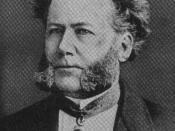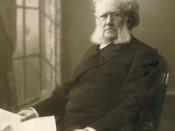The three minor characters Mrs. Linde, Krogstad and Dr. Rank are the main factors contributing to Nora's process of change. The entrances of the different characters are what create tension, drama and conflicts, as well as development in the plot. Certain of these character's aspects also support the thematic issues. Nora changes and reveals herself increasingly as these characters enter her life.
When Mrs. Linde enters Ibsen has already established the characteristics of Nora. She has been presented to the audience as selfish, not very bright and as a generally shallow person. Ibsen uses their first conversation together to show us Nora's attitude towards other people. For example how insensitive she is regarding others feelings: "How you've changed, Christine!" in other words "how old you look". She also tends to use childish vocabulary in her speech, such as "the big thing" and "pooh". One detects an ignorance concerning the "outside world", as, together with her husband, they have created a sort of artificial environment within their home.
Helmer is the one in charge of their affairs, and she is his entertainment, this is shown by statements like "is that my skylark twittering out there?" and "when did my squirrel come home". The use of pet names gives an image of an animal trapped in its cage. As Nora hears about Mrs. Linde's life, the death of her husband, her caring for her mother and family and so on, we sense she feels a need within her to prove herself. She wants to prove that she has had just as many responsibilities and difficulties as her old friend. It becomes clear to us that the entrance of Mrs. Linde sets off a reaction within Nora. I think she finally starts to consider her own life personally as well as...


